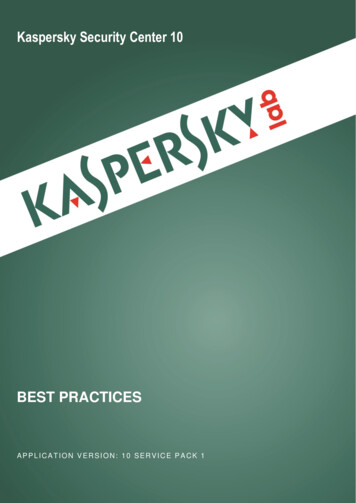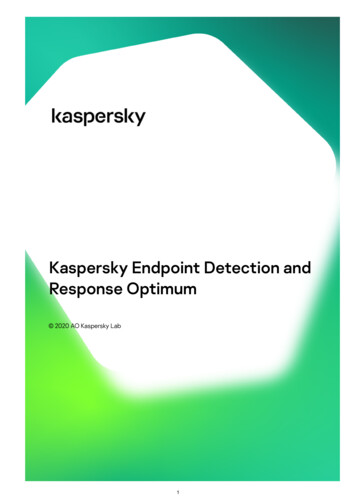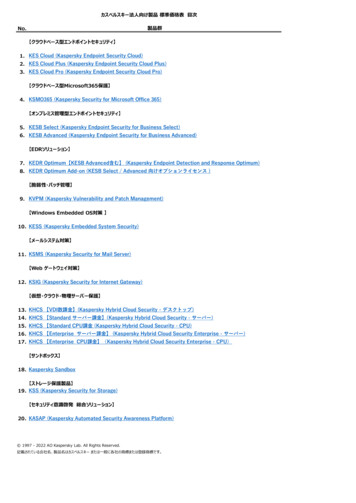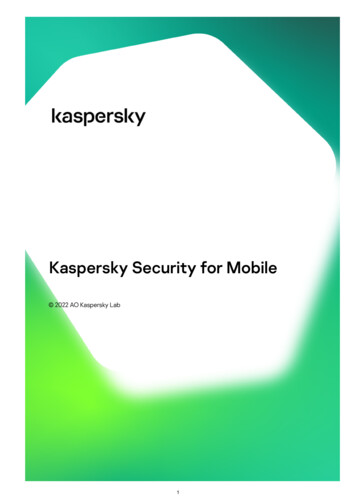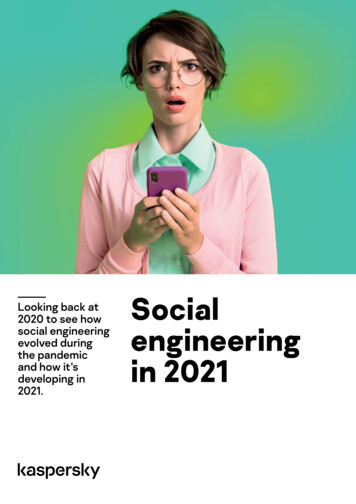
Transcription
Looking back at2020 to see howsocial engineeringevolved duringthe pandemicand how it’sdeveloping in2021.Socialengineeringin 2021
Adapting to a new normal2020 was an unprecedented year. As large swathes of the world’s population were forcedinto one form of lockdown or another, our lives changed forever. The internet became ourworkplace, our classroom, where we shop and conduct business. It also became a lifelineas the only means to keep in touch with loved ones. In response, businesses had to rushtheir digital transformation efforts, delivering in a matter of weeks what would normallyhave taken years, with varying degrees of success. Combined with the inevitable financialcrisis, many businesses were forced to shut down and some industry sectors, such ashospitality and non-food retail, were particularly affected. On the other hand, digitallynative businesses and those that could still innovate in the face of adversity were betterable to weather the storm, from restaurants becoming digital takeaways to grocerystores converting to online ordering and delivery in a matter of weeks, to name but a few.This is when “working from home” (#WFH) replaced all previous nomenclature around“flexible working” and Zoom became a verb1.Share of 49%FranceGermany30%0%United KingdomZeroOneTwoThreeFour24%Five and moreFigure 1 Statista 20202The challenging economic conditions also meant that many lost their jobs. Newemployment trends emerged, such as increased participation in the gig economy, andmany of those previously in traditional full-time employment were forced to pursue gigor temporary work for supplementary or even primary income. Governments also hadto scramble new digital processes to manage the healthcare and financial crises, eitherby launching contact tracing apps, or by finding ways to deliver financial stimulus orbenefits packages without excluding segments of the coronavirus-working-from-home-in-europe/2
Changing behaviorsYounger generations were traditionally at the forefront of digital adoption, but thepandemic also changed that. By necessity, older demographic segments – oftentechnology averse – acquired new behaviors, as evidenced by the increase in first-timeusers across the spectrum of digital services3:Digital adoption rate, by industry1Regular users2% of digital usersHighest adoptionLowest adoptionFinlandRomania32SpainCzech ed 5BankingEntertainment36Social 6First-time users during COVID19- crisis48Utilities2610Public sector231134FinlandRomania38634United 83678Highest - lowest331Figure 2 McKinsey 20204For individuals, this increased, often forced, digitization, has brought new risks whichare difficult to address given the pace of adoption. Unsurprisingly, according to the lastFBI Internet Crime Complaint Center (IC3) 2020 Internet Crime Report5, the older youare, the more you have to lose:2020 VICTIMS BY AGE GROUPVictimsAge RangeTotal CountTotal LossUnder 2023,186 70,980,76320-2970,791 197,402,24030-3988,364 492,176,84540-4991,568 717,161,72650-5985,967 847,948,101Over 60105,301 966,062,236h e-digital-a-plan-for-the-first90-days#4h rages5h ttps://www.ic3.gov/Media/PDF/AnnualReport/2020 IC3Report.pdf6h -breach3As for organizations, they were forced into changing their working practices, withmany more people – often in positions of trust – working from home or other remotelocations, they were faced with the challenge of ensuring that the comparative safetyof the “corporate infrastructure” was replicated in this often unfamiliar “distributedinfrastructure” where the distributed locations were than 1,000 sensitive files opento every member of staff6. For criminals, compromising employees can lead to anexceptional bounty .
For many companies, the changes deployed in 2020 were only the first steps on thisnecessary journey. Outdated processes required re-modelling, machine learningmodels needed to be re-evaluated6, and new or exacerbated risks required adequatemitigation. Not unexpectedly, major risks linked to increased cybercrime fraud emergedduring the first year of the pandemic. Consequently, cybercrime cost the world 1 trillion in 20207.The perfect melting potIt is understood that hackers will always capitalize on crises to launch opportunisticattacks, and COVID-19 was no different. Sure enough, as soon as the World HealthOrganization named the global health emergency “COVID-19”, attackers started toactively deploy opportunistic campaigns, taking advantage of local events and news(indeed, the WHO itself was targeted 8):COVID-19 themed attacksFeb - Emotet sustainsoperations usingCOVID-19 luresspreading to Italy, Spain,and English-speakingcountries.Feb 4 - Lokibot followsEmotet’s lead, usingCOVID-19 themed luresin campaigns observedin China and US.Jan 30 - WHO declaresa global healthemergency.Feb 11 - WHO namesthe new diseaseCOVID-19.Mar 3 - Trickbot startsusing to use COVID-19lures in campaigntargeting Spain, France,and Italy, Trickbot goeson to become the mostprolific malwareoperation usingCOVID-19 themed lures.Mar 13 - A Czechhospital is hit bya known ransomwareactorMar 17 - COVID-19 mapthemed malware observedin Europe leadsto human-operatedransomware Ryuk.Feb 29 - The UnitedStates records firstcoronavirus death andannounces travelrestrictions.Mar 15 - Malvare usingCOVID-19 map themeslures start appearing.The ransomware actor thatattacked Czech hospitalcontinues to actively targethealthcare, software, andcritical infrastructure.By late March, every countryin the world has seen at least 1COVID-19 themed attack.Mar 26 - The US becomescountry with highest numberof confirmed coronaviruscases.Mar 11 - WHO declaresCOVID-19 a pandemic.JAN.FEBRUARYMARCHAPRILActive threat monitoring and responseMicrosoftBoth Google and Microsoft performed extensive research on the effects of thepandemic on online security threats9 10, and the consensus is that criminals capitalizedon the need for information for both businesses and individuals as the crisisevolved. However, the global malware trends remained fairly stable and criminalsmerely repurposed their existing infrastructures lures and malware to geographicalcircumstances: whilst we observe an opportunistic peak in COVID-19 themed attacksin early March, this soon settled into a new normal (and COVID-19 has just becomeone other lure amongst many). As criminals continued to social engineer their wayinto businesses to deliver their payloads, compromise infrastructures and harvestcredentials to commit further crimes, some industries were more affected than others.h hine-learning-models-hit-hard-bycovid7h -world-over-dollar1-trillion-in-2020/8h es-idUSKBN21K1RC9h covid-19-and-online-security-threats/10 ing-the-outbreak/6
No honor amongst thievesSadly, as the crisis evolved, criminals targeted key industries and several ransomwaregroups that had already compromised multiple infrastructures, mostly through socialengineering, activated numerous ransomware deployments in April 2020. And becausethe pandemic was an opportunity not to be wasted, they specifically focused onhealthcare, aid organizations, medical billing companies, manufacturing, transport,government and educational institutions, with no regard to the devastating humanimpact11. Indeed, according to the IBM X-Force Report12, nearly one in four cyberattackslast year was ransomware, while the increase in data extortion efforts – a newphenomenon – enabled one ransomware hacking group to make over 123 million inprofits in 2020, especially targeting those organizations that couldn’t afford downtime.However, these critical sectors were not the only ones under threat, and not even thosethat suffered the most: healthcare was only the seventh-most targeted sector in 2020,up from last place in 2019. In second and third places respectively, the manufacturingand energy sectors were specifically targeted during the pandemic, mostly as a resultof industrial control systems (ICS) and legacy environment vulnerabilities13.Not unexpectedly, the finance and insurance industry topped the list of mostattacked for the fifth year in a row (IBM X Force), as the pandemic created the perfectenvironment for financial fraud to thrive. Experian dubbed COVID-19 “the gateway tofraud” 14 and identified the five most prominent threats in 2020: Authorized push payment (or wire transfer) fraud (BEC, EAC)Account takeover fraudAccount opening fraudTransaction payment fraudSynthetic identity fraud (also known as fictitious identity fraud)And this is where most of the impact is felt: social engineering remains the mostprominent way of committing crime by attacking not only businesses but individuals, asevidenced by the latest FBI/IC3 report:2020 CRIME TYPES2020 CRIME TYPES CONTINUEDBy Victim CountBy Victim LossCrime TypeVictimsCrime ent/Non-DeliveryExtortionPersonal Data BreachIdentity TheftSpoofingMisrepresentationConfidence Fraud/RomanceHarassment/Threats of ViolenceBEC/EACCredit Card FraudEmploymentTech SupportReal Estate/RentalAdvanced FeeGovernment epstakes/lnheritanceIPR/Copyright and CounterfeitCrimes Against ChildrenCorporate Data Breach RansomwareRansomwareDenial of Service/TDoSMalware/Scareware/VirusHealth Care RelatedCivil MatterRe-shippingCharityGambling Terrorism ВЕС/ЕАСConfidence ntity TheftSpoofingReal Estate/RentalPersonal Data BreachTech SupportCredit Card FraudCorporate Data BreachGovernment ImpersonationOtherAdvanced nsomwareHealth Care RelatedCivil ssment/Threats -shippingCrimes Against ChildrenDenial of Service/TDosHacktivistTerrorism 1,866,642,107 600,249,821 336,469,000 265,011,249 219,484,699 216,513,728 213,196,082 194,473,055 146,477,709 129,820,792 128,916,648 109,938,030 101,523,082 83,215,405 70,935,939 62,314,015 61,111,319 54,241,075 51,039,922** 29,157,405 29,042,515 24,915,958 19,707,242 6,904,054 6,547,449 5,910,617 4,428,766 3,961,508 3,095,265 660,044 512,127 50 0h ttacks-doubled-in-2020-with-28-tied-to-ransomwareh ponse-Efforts-Double13h -industrial-control-systems14h s-to-watch-out-for-in-2020/1112
The listed crimes are not new, and the trends continue to reflect what we alreadyknow: criminals will continue to capitalize on opportunities, and the pandemic gavethem plenty. Whether through capitalizing on world events and local knowledge –as observed with the attacks on the healthcare extended supply chain and thoseassociated with it – or on individuals suffering with the mental exhaustion brought onby the pandemic, as evidenced with the increase in phishing attacks and confidencefraud/romance scams. As the world becomes more secure, targeting individuals –whether in their personal lives or as employees of companies – is easier and far morelucrative than mounting “sophisticated” attacks on technology, and the rewards arepotentially much higher. After all, if one individual is compromised and credentials arelost, criminals have the keys to the kingdom and don’t have to worry about evadingtraditional technological security measures.Because of the sheer volumes involved with a pandemic, criminals adapted rapidly tocapitalize on their investments. This is why we saw the increase of ransomware-as-aservice, and the double-extortion tactics (i.e., ransom and then threaten to leak data)and any variations of corporate-like operating models (e.g., outsourcing part of theprocess to specialists in specific attacks). This was also facilitated by the increased useof cloud infrastructures, as numerous businesses that rushed into “digital” unwittinglyleft unsecure servers exposed for all to see .Fighting back Looking back at 2020, we soon realize that there was nothing new. Granted, newindustries and demographic segments were targeted, some attacks increased, butthe ways criminals operated during the pandemic is no different to the way they havealways operated when presented with the opportunity of a global event (e.g. the 2018Olympics15). The kill chain remained the same:Actionson ObjectivePhysical andreputationaldamageCommandand onReconnaissanceKill chain stepFigure 3: Attack lifecycle (kill chain)16A large proportion of businesses were already compromised prior to the pandemic(e.g., payloads lying dormant), the pandemic gave criminals the perfect opportunityto complete the cycle. Furthermore, increased digitization and cloud adoption gavecriminals the perfect opportunity to enact the kill chain even more rapidly by targetingnewly digital businesses and individuals, where survival, not security, was the focus.h h oads/sites/43/2018/03/07171449/Incident Response Guide eng.pdf17h s businesses worldwide start to recover and stabilize their operations, moving fromsurvival to sustainability, and as individuals see hope in the easing of lockdowns, one thingis certain: we will not go back to the way we were. Growth still presents a challenge, anddigitization is here to stay. To maintain trust, businesses must now understand that theircustomers and partners not only have high expectations of convenience but equally highexpectations for security17. And as we enter this next phase, the fundamental securityprinciples remain the same as they always have been: deploy processes in line with thenew normal, train people to recognize threats, and use technologies (and don’t be afraidof new technologies) that best support the security posture. Of course, all this needs tobe applied through the lens of confidentiality, integrity and availability.
For example, the need for better authentication in all aspects of digital interactionshas never been more pressing: whether looking at Privileged Access Management,Identity and Access Management, or Strong Customer Authentication or Zero Trustarchitectures, businesses should have a clear understanding of where they need tostrengthen their environment.Another example is combating phishing and other forms of social engineering. These arenot new threats and should be well understood. Preventing phishing impersonation willmitigate the risk of brand impersonation, yet DMARC deployment globally is still not whereit should be18, and of course user training to recognize phishing interactions is crucial, as wellas the appropriate governance processes to prevent scams such as APP and BEC.When it comes to vulnerabilities, organizations would do well to always consider theOWASP Top 1019, as well as the OWASP Top 10 Mobile20, given the increase in digital andmobile usage worldwide.The list of recommendations could go on, but it will not show anything new. The trick isto deploy a layered approach and manage risk according to the business appetite andcircumstances.Looking ahead According to Forrester21, the following five threats could hobble recovery:Misinformation and espionage: those in critical sectors such as government andhealthcare and their supply chains should take advantage of industry and governmentthreat intelligence sources to be prepared to counter this risk.Insider threats: as the world moves towards recovery, there will be many employmentcasualties. As organizations move more and more towards digital operations andgovernment relief packages peter out, redundancies are to be expected as businessesare forced to make tough decisions. This will leave many employees disgruntled as theyface unemployment and these could turn into insider threats. Businesses are advisedto deploy the appropriate governance processes and technologies that could preventthis from happening.Identity theft and account takeover: this risk, whilst not new, is expected tocontinue on its upward trajectory as digital interactions continue to increase.Businesses are advised to consider deploying or enhancing the measures highlighted inthe previous section.Bot attacks: criminals use technology too, and to make their operations more efficient,they will use means to automate their processes. Bot attacks have been on the risefor the past couple of years and this trend will continue. Attacks such as inventoryhoarding, credential stuffing, ad fraud, and web scraping will continue to rise andbusinesses are advised to deploy preventative measures.COVID-19 apps: contact tracing apps and immunity passports will be particularly atrisk in 2021 as they become mainstream. Those involved should deploy best practices ininformation security and data privacy to counter this threat.h -301239190.html19h ttps://owasp.org/www-project-top-ten/20h ttps://owasp.org/www-project-mobiletop-10/21h e-5-threats-could-hobblepandemic-recovery/18
Fortunately, current regulatory developments have driven enhanced security globally,such as seen with PSD2 in Europe and the various data protection and Anti-MoneyLaundering regulations worldwide. In the UK, the fight against APP fraud is under way, withthe adoption of the Contingent Reimbursement Voluntary Code of Conduct (an initiativeto reimburse victims) which has gained traction beyond the original signatories22 as well asthe continuing deployment of Confirmation of Payee. In addition, technology giants areunder increasing pressure to fight scams and protect victims23 24 25. Increased cooperationcan only be a good thing. In addition, many businesses are now adopting layeredapproaches to counter these threats. With the relentless increase in digital interactions,more and more focus is placed on the customer experience, and businesses must ensurethat these experiences are not only seamless, but secure. Customers no longer feelsafe with passwords26, and multi-factor authentication is gaining a lot of traction, withbiometrics now part of life27. But as interactions become more immediate, the needfor real-time visibility has led to even additional factors such as physical biometrics(e.g. face recognition, fingerprints, etc.) to being increasingly supplemented by morecontextual features such as behavioural biometrics and analysis (e.g. typing behaviour,page interaction, etc.), contextual device and environment analysis and the likes. Luckily,technology innovation doesn’t just serve criminals.Be prepared The pandemic brought with it increased digitization and increased risks. But examiningattack patterns, we soon realize that it is nothing we haven’t seen before. Granted, thereis more technology to take advantage off, there are more opportunities presented tocriminals, but we know how to address these risks. The only difference perhaps is, astechnology advances, there are many more ways to counter threats than ever before.Let’s take advantage of these innovations within tried and tested risk management andgovernance processes, and apply common sense. That will go a long way .h -authorised-pushpayment-scams23h f8e73abe56524h s25h s/26h -MostSecure-Method-for-Authentication27h -says22Cyber Threats News: www.securelist.comIT Security News: business.kaspersky.comCybersecurity for SMB: kaspersky.com/businessCybersecurity for Enterprise: kaspersky.com/enterprisekfp@kaspersky.com 2021 AO Kaspersky Lab.Registered trademarks and service marks are the property of theirrespective owners.We are proven. We are independent. We aretransparent. We are committed to building a saferworld, where technology improves our lives. Whichis why we secure it, so everyone everywhere has theendless opportunities it brings. Bring on cybersecurityfor a safer tomorrow.Known more at kaspersky.com/transparency
attacked for the fifth year in a row (IBM X Force), as the pandemic created the perfect environment for financial fraud to thrive. Experian dubbed COVID-19 "the gateway to fraud"14 and identified the five most prominent threats in 2020: Authorized push payment (or wire transfer) fraud (BEC, EAC) Account takeover fraud
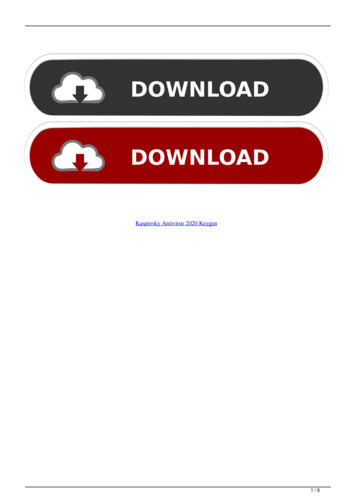
![Kaspersky Antivirus 6.0.4.1424. Key File 18 [REPACK]](/img/59/maramon.jpg)



![Kaspersky Password Manager 9.0.1.447 Crack [BETTER]](/img/55/kaspersky-password-manager-901447-crack-better.jpg)
